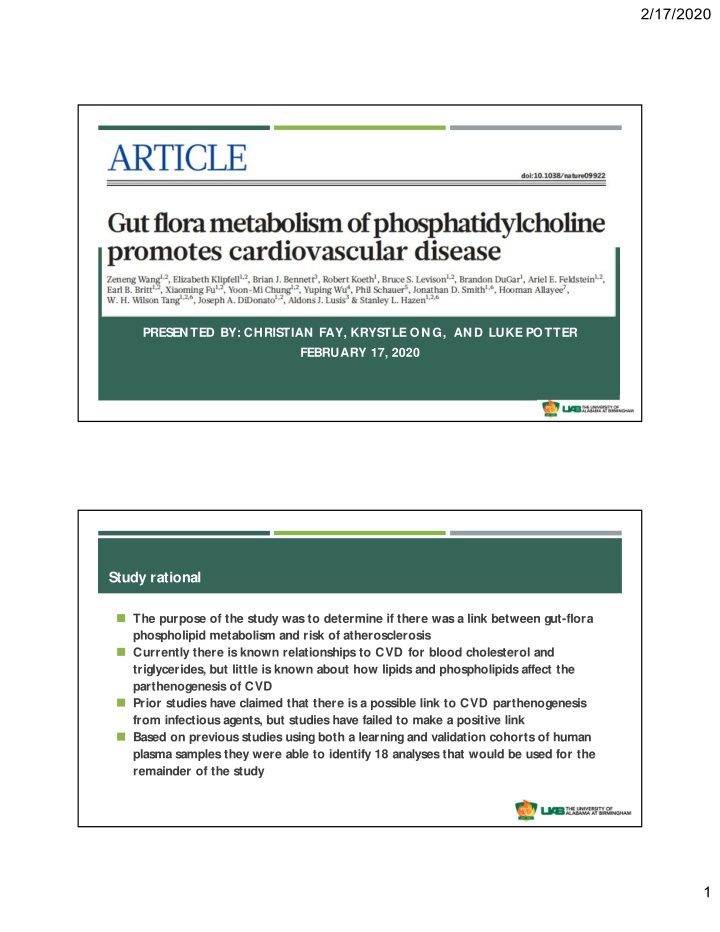



2/17/2020 PRESEN TED BY: CHRISTIAN FAY, KRYSTLE O N G, AN D LUKE PO TTER FEBRUARY 17, 2020 Study rational ◼ The purpose of the study was to determine if there was a link between gut-flora phospholipid metabolism and risk of atherosclerosis ◼ Currently there is known relationships to CVD for blood cholesterol and triglycerides, but little is known about how lipids and phospholipids affect the parthenogenesis of CVD ◼ Prior studies have claimed that there is a possible link to CVD parthenogenesis from infectious agents, but studies have failed to make a positive link ◼ Based on previous studies using both a learning and validation cohorts of human plasma samples they were able to identify 18 analyses that would be used for the remainder of the study 1
2/17/2020 Sample preparation/analytical platform ◼ Lipids were extracted using a chloroform:methanol method ◼ Metabolites were analysed after running through a phenyl column using a cohesive HPLC with a PE Sciex API triple quadrupole mass spectrometer ◼ Targeted analysis was used ◼ Metabolites isolated from HPLC were vacum dried and dissolved in water ◼ Redisolved metabolites were put back through the phenyl column with a HLPC gradient ◼ 0.2% formic acid over 2 min ◼ 18% acetonitrile containing 0.2% formic acid over 18 min and further ◼ 100% acetonitrile containing 0.2% formic acid over 3 min ◼ GC/MS and TMAO ◼ m/z 76 also included initial reduction by titanium (III) chloride47 and further reaction with 2,2,2- trichloroethylchloroformate ◼ J &W scientific DB-1 column for separations ◼ LC/MS/MS and N MR ◼ LC/M/MS ◼ Used for TMAO , choline, and betaine Method critiques ◼ N o good explanation on how the samples were normalized ◼ N ot clear on how metabolites were analyzed for the initial studies identifying the metabolites studied ◼ W ould have been nice to see untargeted approach to problem to see potential other targets ◼ Based on previous papers, would have been nice to see additional data analysis softwares used to analyze the data ◼ N ot clear on the parameters used for the analysis 2
2/17/2020 Identifying Metabolites of Interest in CVD: TMAO Selection Criteria 1. Statistically significant difference between cases and controls (Bonferroni adjusted two- sided t -test with p <0.05 ) 2. Significant dose-response relationship between analyte level and clinical phenotype (Armitage trend test with p <0.05) 3. Minimal signal-to-noise ratio of 5:1 for the given analyte TMAO Identifying Metabolites of Interest in CVD: Choline 3
2/17/2020 Identifying Metabolites of Interest in CVD: Betaine The Influence of Gut Flora on the Production of Plasma Analytes 4
2/17/2020 Dietary PC metabolites predict CVD Risk and Promote Atherosclerosis Hepatic Fmo genes are linked to atherosclerosis and dietary PC metabolites enhance macrophage scavenger receptor expression. ◼ F2 intercross used from atherosclerosis-prone C57BL/6J Apoe -/- and atherosclerosis-resistant C3H/ HeJ Apoe -/- mice 5
2/17/2020 O bligatory role of gut flora in dietary choline enhanced atherosclerosis. CO N CLUSIO N Probiotic supplements, if designed properly, may be a valuable therapeutic method for CVD. 6
Recommend
More recommend